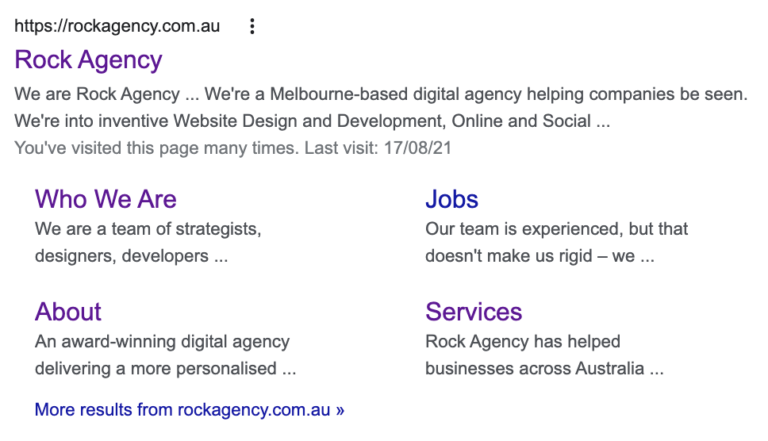4 SEO challenges and solutions for small eCommerce businesses.
In 2021 consumer buying behaviour has favoured online purchases and eCommerce sites. For small businesses this means needing to keep up with the fierce competition faced from large and well known brands across all industries.
To stay ahead of the curve small businesses need to work on their digital presence of which a key component is Search Engine Optimisation (SEO).
What are the objectives of SEO?
Search Engine Optimisation is the practice of increasing the user traffic to your small business’s website. The main goals of SEO include:
- Gaining quality traffic to your website – visitors who are most likely to respond to your call to action. For example: ‘Purchase’ your product; or ‘Contact’ you for a business query relating to your service offerings.
- Ranking on the first page of Google Search Engine Results Page (SERP) – put simply, when someone does a Google search for your business offerings, your website appears on the first page.
- Brand Awareness – awareness building for your business by ranking for relevant search queries in your area of operations.
Achieving these goals, however, can be difficult especially if you’re a small business or just starting out. When competing with thousands of other brands, it takes a lot more.
4 Challenges of SEO for small businesses
- Lack of familiarity – If you’re starting out or have a small business operation looking to scale up, you need to work out what you expect out of the SEO activities you will undertake. Lots of businesses we’ve worked with have had concerns about not knowing what they should expect out of SEO activities. For example, if you’re a restaurant owner in your local area, what searches do you want your website to be associated with? Is it showcasing that your restaurant is the most-loved restaurant in the area? Or given that online delivery is a favoured option now due to several lockdowns restricting onsite dining, do you want to be associated with online delivery menus? Perhaps even both?
- Lack of content – Depending on your business type and the products/services you offer, you need to explain your business well enough for readers to stay and engage with your website. For example, if you’re a business that sells active wear for young adults, your objective should be to offer as much information to your audience about your product as possible, in a way that’s interesting and exciting to them. As well as standard product specifications, include rich media such as imagery, video content, customer testimonials and in-depth information about the product.
- Lack of understanding of end consumer needs – Sometimes business owners misunderstand end-user requirements and create a website based on what they ‘perceive’ to be the end-user sentiments. This leads to creating a website and an SEO plan based on assumptions and not actual market data. For example, you may need to widen your market research strategies and use strategic tools such as surveys to engage in online discussions about your business offerings. You’re looking for a better understanding of what your audience expects when they visit your website.
- Treating SEO as a once-off activity – SEO is a process that takes time if you’re to reap significant and visible positive impacts. An SEO strategy that you develop today may not rank your website well in the next month due to many factors such as market changes, business changes, consumer needs shifting, etc. It’s imperative to have an ongoing SEO optimisation strategy that keeps your business on top of these standards.
These challenges are pretty common and luckily there’s a solution to each of them to help you gain maximum SEO benefit for your business.

4 essential and easy to undertake SEO solutions that will help your small business.
Before we jump into these solutions, it’s important to note that these are only the basic activities you might use as a starting point. Post these strategies there’s even more to consider – activities like guest blogging, backlink building, technical SEO, etc.
- Start small with a Google search – Yes, it’s that easy to get started! Perform a simple Google search to know what shows up when you type in your business offering. You’ll notice the number of results that show up. Then, check where you rank and where your closest competitor ranks. Accordingly, draft an SEO strategy for that keyword or related keywords. For example, if you know your customers search for ‘online food delivery’, ensure your website includes and talks about ‘online food delivery’ on the page with a clear Call To Action (CTA) of ‘order now’. Visit your competitors’ websites to check how they have laid out their page content.
- Update your content regularly – Think of your website as constantly evolving, as opposed to a set-and-forget entity. You need to optimise because Google rewards highly optimised page content thereby ranking your website higher in search results. When your small business grows, your on-page content needs to grow too. For example, a month ago your online electronics store stocked only iPhone 10s and you had blogs about ‘Top iPhone 10 Features’. Now, you’ve got Androids in stock, plus iPhone 13s, which means your blog section needs to reflect this. Create a comparison blog, for example – ‘Difference between the iPhone 13 and the Pixel 5a’ – or similar. By keeping content fresh you keep those Google rankings climbing.
- Update your Google My Business profile – Google My Business is a medium with which your business can easily engage with more customers performing a google search…. and it’s free! As Google says: ‘You get more than a business listing. Your free Business Profile lets you easily connect with customers across Google Search and Maps.’ This helps your business showcase business trading hours, customer reviews, and an overview of everything that you do. If you’re a small business, say a local coffee house that has specific information to communicate such as your trading hours on weekdays/weekend and the amazing customer reviews on your unmatchable brew, this is what you need to update. This can work wonders, especially for local-area gains.
- Get meta titles and descriptions correct – Updating your website content is key but so is how that content shows up on Google search results. Google picks up 2 key things from your website’s backend – meta titles and meta descriptions and displays those results on search pages. Aim for your meta titles and meta descriptions to be as accurate and representative of your webpage as possible. You need to ensure each page has unique meta content. This helps Google identify and display the correct information about your business. The aim should be to ensure that the meta content is in line with what the user intent is. For example, if your chocolate selling retail store sells dairy free and vegan chocolates, ensure your ‘chocolates’ page meta description highlights that. For example: ‘We sell a wide variety of chocolates including dairy free, vegan and more. Learn More.’
This is in line with a possible search term ‘vegan chocolates near me’. Therefore, the consumer knows what they will see when they open your webpage and that is crucial for a good user experience on your website.
Look at Rock Agency’s example below for reference.
Image: Rock Agency google search results.
- Create a mobile-friendly website – Almost 50% of website searches that come to your website are likely to convert on mobile devices. Google has been a big advocate of ranking mobile-friendly websites that have good page load speeds higher in search results. You don’t necessarily need to have a separate website for mobile, as a website design that is responsive to mobile works best. You need to ensure that your small business website has the below, on mobile:
- Well laid out content – Structure of the content should be in a consistent format across the website.
- Structure of menu – the menu needs to be semantically laid to inform the user of the headers and sub sections.
- Rich media size – a key aspect of ensuring that your website has a good page speed is to upload mobile optimised images. (.JPGs preferred)
TIP: Free tools such as Google Lighthouse can give you a brief overview of your current SEO score, page load speed on mobile and desktop and overall performance of your site with a few basic steps to improve these aspects.
These were just a few easy yet essential tactics that your small business can take advantage of in understanding the primary challenges and solutions of SEO for small business.
Learn more about our SEO Services
For more information on the different types of SEO optimisations that can be undertaken, checkout our article on Types of SEO.
We’re an award-winning Australian digital agency that specialises in helping small businesses grow with SEO/SEM operations that are well regarded and sought after. Our strategy first approach helps our clients grow.
Get in touch with us to learn how we can help your small business grow with a winning SEO strategy.

